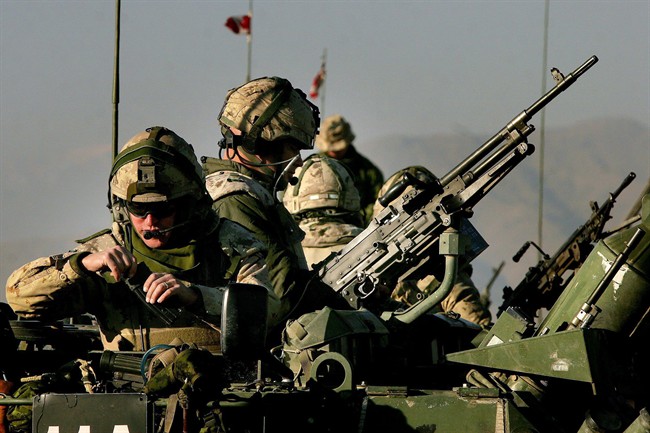A Conundrum of Obesity in Canada's Armed Forces
 |
| Canadian soldiers get ready to leave Camp Julien in Kabul, Afghanistan, Nov. 29, 2005. THE CANADIAN PRESS/AP |
"I think DND [Department of National Defence] was hiding the records because they're embarrassed.""This is information that people have a right to know and information of consequence. Is the military fighting fit or not?""DND claimed it had no such records even though the briefings clearly have a DND and Canadian Forces logo on them."Researcher Ken Rubin"CAF [Canadian Armed Forces] surveys also study eating patterns, barriers to healthy eating, and chronic conditions.""BMI at the population level is a practical and useful tool, especially to compare data over time, even if it has limitations.""[The Canadian Forces does not track data] on the number of members who have been subject to administrative action or release in relation to physical fitness issues that may cause medical employment limitations.""An administrative review determines the most appropriate action, if any, to deal with the matter, and is conducted in a transparent manner with a focus on procedural fairness."DND spokesperson Andree-Anne Poulin
 |
In
1989 when the Canadian Armed Forces were at full staffing levels --
which they are not now at -- an interior study concluded that five
percent of the 88,000 regular force was judged to be obese, and another
17 percent was considered to be overweight. At that time, 15 percent of
Canadians were thought to be obese, while 15 percent were seen to be
overweight. Qualifying any serving member of a military as obese or
overweight does not augur well for fitness to serve in combat roles in
defence of their nation.
Fast
forward to the present era, and what was seen as deplorable decades
earlier seems in retrospect slight numbers of questionable fitness of
individuals to serve in the military. As evidenced by shocking new data
revealing that troops enlisted in the Canadian military have degenerated
to the point where 72 percent of armed forces personnel fall into the
categories of overweight and obese. Senior leaders were evidently warned
of this increasing phenomenon of unhealthy fitness levels in the Forces
in June 2024 contained in briefings warning that "Obesity prevalence has been slowly increasing for many years".
One
of the results of which has been an increase in sick days and medical
releases, as well as reduced readiness and productivity in the pursuit
of the profession. And this, at time when recruitment is at an
historically low level. In the Canadian Armed Forces, today's reality is
that forty-four percent are categorized as overweight, and 28 percent
are classified as obese. Such briefings for leaders of the army, navy
and airforce were not released to the public domain, but were revealed
through applications to the Access to Information Act by Ottawa-based
researcher Ken Rubin.
The
Canadian Military, it transpires, has higher rates of both overweight
conditions and obesity than is prevalent in the general population. The
briefings revealed that in comparison to the numbers of obesity and
overweight in the military, for the general population, sixty-eight
percent of Canadian men are considered obese or overweight in comparison
to the 78 percent with those health conditions in the military.
Embarrassing statistics which explain in part why they were never
released for public scrutiny.
In
the military, for example, 57 percent of women enrolled in the military
are either overweight or obese, as opposed to women in the general
population whose numbers in those categories total 53 percent. One
report stated that "increasing physical activity levels will not resolve the challenges of obesity in the CAF".
Military health specialists suggest the promotion of a culture of
fitness through physical activity combined with injury prevention,
adequate sleep and proper nutritional intake.
Mr.
Rubin's request for data from the military through the Access to
Information Act went unfulfilled; the response from the military was to
inform the researcher that no such information existed. Finally, Mr.
Rubin submitted his request to the Canadian Forces Morale and Welfare
Services, separate from DND, and from them he was able to obtain 141
record pages, including the briefs produced by DND on physical fitness
in the ranks.
Short sleep duration (fewer than 6 hours) and borderline short sleep duration (6 hours to fewer than 7 hours) were independently associated with increased odds of obesity for male CAF members, but not for females. These results take into account differences in a range of other factors, including sociodemographic, work and health characteristics of CAF members.Shorter-than-recommended sleep duration, poor sleep quality and obesity are concerns for long-term health, wellbeing and deployment readiness of the military population. Sleep has been identified as an important aspect of physical performance in both the CAF and the US military. Because sleep affects energy balance, eating and physical activity behaviours, it has been identified as a potential tool to aid in managing obesity. Longitudinal or intervention studies are needed to better understand the potential role of healthy sleep practices in obesity management, particularly in military populations.Statistics Canada

Labels: Canadian Armed Forces, Fitness To Serve, Impaired Health, Obesity, Overweight
0 Comments:
Post a Comment
<< Home